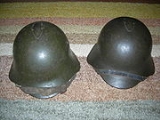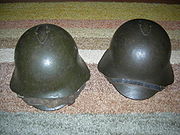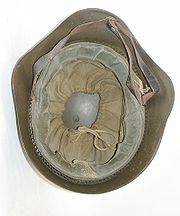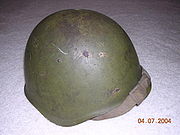
Soviet helmets during World War II
Encyclopedia
Over the course of World War II
the Soviet Union
employed three main helmet
designs; the M-36, the SSh-39, and the SSh-40, each being designated with the year in which they were introduced. Standard practice was to stamp the size, location, and year of manufacturing on the interior of the helmet.

 The M (modyel, or model) 36 was designed by Aleksandr A. Shvartz, and began production in 1936. Its large front rim and wide flares over the ears provided good protection for the wearer. The German M35
The M (modyel, or model) 36 was designed by Aleksandr A. Shvartz, and began production in 1936. Its large front rim and wide flares over the ears provided good protection for the wearer. The German M35
, introduced a year before the Russian M-36, served as a model for the development of the M-36. The M-36 was also fitted with a comb on top, which allowed for ventilation. There were also apocryphal claims that the comb was designed to deflect saber blows.
Early M-36s were made with fragile leather linings. Due to the unreliability of these early models containing leather linings, later variations were introduced with cloth linings. Similar problems were also encountered with early leather chinstraps, so the leather chinstraps were phased out in favor of cloth models as well. Throughout their production four sizes were produced: small, medium, large, and extra large.
The M-36 was worn by Soviet soldiers in several campaigns of the late 1930s and 1940s, including the Khalkin Gol campaign against the Japanese in 1938 (giving it the nickname "Khalkingolka"), the Finnish Winter War of 1939-1940, the 1939 invasion of Poland
, the 1940 invasions of the Baltic states and Bessarabia, and in World War II, or as it is known in Russia, the Great Patriotic War. It was also distributed to the Republican soldiers of the Spanish Civil War
in conjunction with Soviet support of the Spanish government. During the Finnish Winter War, the cold temperatures forced many soldiers to tear out the helmet's liner so the ushanka
, or fur hat, would fit under the metal shell.
Production of the M-36 ended in 1941. Today it is a rare and expensive item for its collectors.
 The SSh (stalnoy shlyem, or steel helmet) 39 was of simple, more modern design, and was much easier to manufacture than the M36. The SSh-39 would be the standard design for Soviet helmets for the next 29 years, with only minor changes occurring during that time. It is also the design for the helmet on the Tomb of the Unknown Soldier
The SSh (stalnoy shlyem, or steel helmet) 39 was of simple, more modern design, and was much easier to manufacture than the M36. The SSh-39 would be the standard design for Soviet helmets for the next 29 years, with only minor changes occurring during that time. It is also the design for the helmet on the Tomb of the Unknown Soldier
in Moscow
. The helmet was produced primarily in three factories, the Stalingrad Tractor Factory (designated CT in the ink stamp), the Red October Factory (3K0) also in Stalingrad
, and the Lysva
Metallurgical Factory (LMZ). The first liner was an eight-finger leather liner, similar to the German M35-M42. Next came a short production of an eight-finger liner made of Gralex. The final version of the SSh-39 liner was cloth, similar to the M-36 liner. All three variations of the liner were suspended from the helmet by three metal tabs, which were riveted to the shell near the top. This helmet, like the M-36, saw action in numerous campaigns before it was phased out in 1942 in favor of the SSh-40.
World War II
World War II, or the Second World War , was a global conflict lasting from 1939 to 1945, involving most of the world's nations—including all of the great powers—eventually forming two opposing military alliances: the Allies and the Axis...
the Soviet Union
Soviet Union
The Soviet Union , officially the Union of Soviet Socialist Republics , was a constitutionally socialist state that existed in Eurasia between 1922 and 1991....
employed three main helmet
Combat helmet
A combat helmet or battle helmet is a type of personal armor designed specifically to protect the head during combat. Helmets are among the oldest forms of personal protective equipment and are known to have been worn by the Akkadians/Sumerians in the 23rd century BC, Mycenaean Greeks since 17th...
designs; the M-36, the SSh-39, and the SSh-40, each being designated with the year in which they were introduced. Standard practice was to stamp the size, location, and year of manufacturing on the interior of the helmet.
M-36


Stahlhelm
Stahlhelm is German for "steel helmet". The Imperial German Army began to replace the traditional boiled-leather Pickelhaube with the Stahlhelm during World War I in 1916...
, introduced a year before the Russian M-36, served as a model for the development of the M-36. The M-36 was also fitted with a comb on top, which allowed for ventilation. There were also apocryphal claims that the comb was designed to deflect saber blows.
Early M-36s were made with fragile leather linings. Due to the unreliability of these early models containing leather linings, later variations were introduced with cloth linings. Similar problems were also encountered with early leather chinstraps, so the leather chinstraps were phased out in favor of cloth models as well. Throughout their production four sizes were produced: small, medium, large, and extra large.
The M-36 was worn by Soviet soldiers in several campaigns of the late 1930s and 1940s, including the Khalkin Gol campaign against the Japanese in 1938 (giving it the nickname "Khalkingolka"), the Finnish Winter War of 1939-1940, the 1939 invasion of Poland
Soviet invasion of Poland
Soviet invasion of Poland can refer to:* the second phase of the Polish-Soviet War of 1920 when Soviet armies marched on Warsaw, Poland* Soviet invasion of Poland of 1939 when Soviet Union allied with Nazi Germany attacked Second Polish Republic...
, the 1940 invasions of the Baltic states and Bessarabia, and in World War II, or as it is known in Russia, the Great Patriotic War. It was also distributed to the Republican soldiers of the Spanish Civil War
Spanish Civil War
The Spanish Civil WarAlso known as The Crusade among Nationalists, the Fourth Carlist War among Carlists, and The Rebellion or Uprising among Republicans. was a major conflict fought in Spain from 17 July 1936 to 1 April 1939...
in conjunction with Soviet support of the Spanish government. During the Finnish Winter War, the cold temperatures forced many soldiers to tear out the helmet's liner so the ushanka
Ushanka
An ushanka , also known as a trooper, is a Russian fur cap with ear flaps that can be tied up to the crown of the cap, or tied at the chin to protect the ears, jaw and lower chin from the cold. The thick dense fur also offers some protection against blunt impacts to the head...
, or fur hat, would fit under the metal shell.
Production of the M-36 ended in 1941. Today it is a rare and expensive item for its collectors.
SSh-39

Tomb of the Unknown Soldier
Tomb of the Unknown Soldier refers to a grave in which the unidentifiable remains of a soldier are interred. Such tombs can be found in many nations and are usually high-profile national monuments. Throughout history, many soldiers have died in wars without their remains being identified...
in Moscow
Moscow
Moscow is the capital, the most populous city, and the most populous federal subject of Russia. The city is a major political, economic, cultural, scientific, religious, financial, educational, and transportation centre of Russia and the continent...
. The helmet was produced primarily in three factories, the Stalingrad Tractor Factory (designated CT in the ink stamp), the Red October Factory (3K0) also in Stalingrad
Volgograd
Volgograd , formerly called Tsaritsyn and Stalingrad is an important industrial city and the administrative center of Volgograd Oblast, Russia. It is long, north to south, situated on the western bank of the Volga River...
, and the Lysva
Lysva
Lysva is a town in Perm Krai, Russia, located in the eastern part of the krai on the Lysva River, from Perm. Population: It was founded in 1785 as a place of residence for industrial workers. In 1926, it was granted town status....
Metallurgical Factory (LMZ). The first liner was an eight-finger leather liner, similar to the German M35-M42. Next came a short production of an eight-finger liner made of Gralex. The final version of the SSh-39 liner was cloth, similar to the M-36 liner. All three variations of the liner were suspended from the helmet by three metal tabs, which were riveted to the shell near the top. This helmet, like the M-36, saw action in numerous campaigns before it was phased out in 1942 in favor of the SSh-40.

